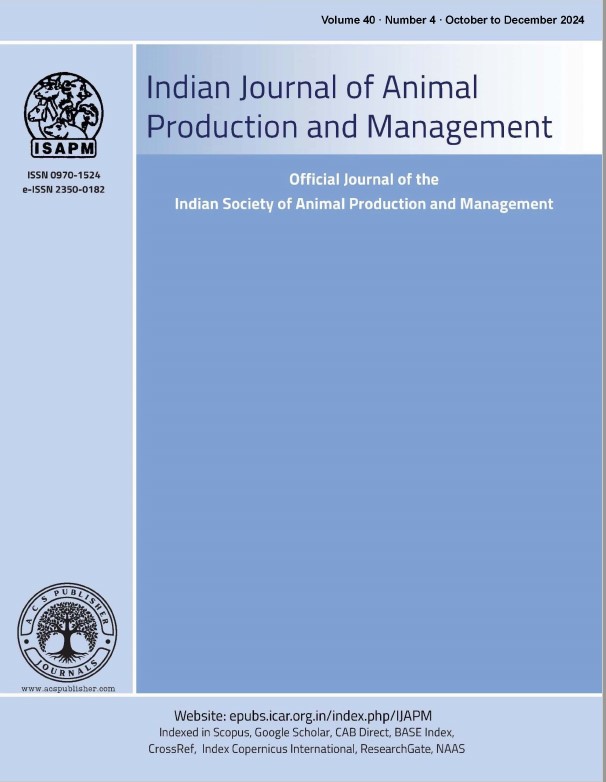Assessment of Phenotypic and Reproductive Characteristics of Local Donkeys in Marathwada Region
DOI:
https://doi.org/10.48165/ijapm.2024.40.2.3Keywords:
local donkeys, Marathwada, Maharashtra, phenotypic characters, reproductive charactersAbstract
A total of 1007 local donkeys were selected for the study of phenotypic and reproductive characters of local donkeys from different districts of the Marathwada region in Maharashtra state. Statistically non-significant differences were found in most of the phenotypic parameters. Four different body coat colour patterns i.e., grey, brown, white, and dark red brown were observed with percentage as 48.46, 21.54, 25.12 and 4.86%, respectively. Most of donkeys (96.02 %) were black muzzled with convex forehead (93.24%), white marking above muzzle (66.53%), white marking above eyes (67.72%), white marking posterior to the mandible (70.30%), dark brown lining around extremity of ear pinna (88.97 %), long white hairs at inner side of ear pinna (100%) and bearing dark strip starting from poll to switch of tail and forming cross with another dark strip at shoulder (73.48%). The mean age at puberty, age at first service, age at first oestrus, oestrus cycle duration, oestrus duration, age at first covering, age at first conception, no. of services/conception, age at first foaling, service period, foaling interval, gestation period, lifetime no. of foaling of adult female local donkeys in Marathwada region were 2.70±0.02 years, 2.79±0.02 years, 2.77±0.03 years, 6.86±0.084 days, 23.80±0.55 days, 2.96±0.01 years, 5.9±0.07 years, 1.82±0.06, 4.44± 0.01 years., 1.14±0.01 years, 2.25±0.01 years, 340.8±0.27 days and 5.98±0.07, respectively.
References
th Livestock census (2012), Department of Animal Husbandry and Fisheries, Ministry of Agriculture, Government of India.
th Livestock census (2019), Department of Animal Husbandry and Fisheries, Ministry of Agriculture, Government of India.
Aliyu, T. U., Adamu, L., Mairiga, I. A., Kyari, F., Bukar, M. M., Isaac, O., ... & Ismail, S. (2022). Prevalence, associated risk factors, morphological and molecular characterization of piroplasms in the blood of infected donkeys from Gombe and Yobe States, Nigeria.
Behl R, D. K. Sadana, J. Behl, S. Kumar, V. Kedar and B. K. Joshi (2013). Donkey Genetic Resources of India – Sindhi Donkeys. National Bureau of Animal Genetic Resources Publication (Monogram 80/2013)
Behl R., A.M. Sadana and J. Behl (2009). Donkey An undervalued animal genetic resource of India. Livestock International 12: 5–8.
Behl, R., D. K. Sadana, J. Behl, P. Banerjee, J.
Gond et al.
Joshi, R. Vijh, and B. K. Joshi (2017). Characterization and microsatellite analysis for genetic diversity and bottlenecks of Spiti donkey. Indian Journal of Animal Sciences, 87(10), 1221-1225.
Behl, R., S. K. Niranjan, J. Behl, P. Ranjan, V.K. Bharti, and M. Iqbal, 2019. Comparison of Ladakhi donkeys with three other donkey populations of India based on morphometric attributes. Indian Veterinary Journal, 96(8), 20-
Ebangi, A. L., & Vall, E. (2005). Dry season effect on live weight and some body dimensions of working donkeys in the Sudano-sahel region of Cameroon. Tropicultura, 23(1), 48.
Food and Agricultural Organization Statistics (FAOSTAT) 2013.
Gichure, Joshua, Onono Raphael Wahome, and Peter Gathura, 2020.Assessment of Phenotypic Characteristics and Work Suitability for Working Donkeys in the Central Highlands in Kenya. https://doi.org/10.1155/2020/8816983
John P.A., G.N. Akpa, and A.O. Iyiola-Tunji, 2017.Characterization of weaner donkeys in North West Nigeria using morphometric traits. Nigerian Journal of Animal Science, 19(1), 36-
Labbaci M, A. Djaout, M. Benyarou, A. Ameur Ameur, S.B.S. Gaouar, 2018. Morphometric Characterization and Typology of Donkey Farming (Equus asinus) in the Wilaya of Tlemcen Gen. Biodv. J. 2(1): 60-72
Nengomasha, E.M., R.A. Pearson and T. Smith, 1999. The donkey as a draught power resource in smallholder farming in semi-arid western Zimbabwe. 1. Live weight and food and water requirements. Anim. Sci.-Glasg. 69: 297– 304.
Orhan, Y. and E. Mehmet, 2012.The Morphologic Traits of Donkeys Raised In East And Southeast Of Turkey,” HayvansalUretim ,Vol. 53, No. 1, Pp. 10–13,
Pal, Yash.,R.A. Legha, Niranjan.Lal,Bhardwaj, Anuradha, Chauhan, Mamta and Gupta, Ashok., 2013.Management and phenotypic characterization of donkeys of Rajasthan. Indian Journal of Animal Sciences.83. 793-797.
Singh M K, A K Gupta and M P Yadav 2007. Performance evaluation of donkeys in arid zone of India. Indian Journal of Animal Sciences 77: 1017–20.
Yun, S., and G. Cho, 2017.Molecular genetic diversity of donkey (Equus asinus) in South Korea. bioRxiv, 213520.

